Exploring Diet in the Middle Ages in Northeastern Portugal (Bragança) Through Dental Calculus: The Cases of Torre Velha (Castro De Avelãs) and Mós (Torre De Moncorvo)
Abstract
1. Introduction
Archaeological Background
2. Materials and Methods
3. Results
4. Discussion
4.1. Starch Grains and Their Significance
4.2. Other Vegetal and Fungal Structures
4.3. Insights into Diet in the Middle Ages in Northeastern Portugal
5. Conclusions
Supplementary Materials
Author Contributions
Funding
Data Availability Statement
Acknowledgments
Conflicts of Interest
Abbreviations
| TVCA | Torre Velha |
| MOTM | Mós |
References
- Eden, B.D. Prevention strategies for periodontal diseases. In Prevention in Clinical Oral Health Care; Capelli, D.P., Mobley, C.C., Eds.; Elsevier Inc.: Amsterdam, The Netherlands, 2008; pp. 213–229. [Google Scholar] [CrossRef]
- Fons-Badal, C.; Fons-Font, A.; Labaig-Rueda, C.; Solá-Ruiz, M.; Selva-Otaolaurruchi, E.; Agustín-Panadero, R. Analysis of predisposing factors for rapid dental calculus formation. J. Clin. Med. 2020, 9, 858. [Google Scholar] [CrossRef]
- Radini, A.; Nikita, E.; Buckley, S.; Copeland, L.; Hardy, K. Beyond food: The multiple pathways for inclusion of materials into ancient dental calculus. Am. J. Phys. Anthropol. 2017, 162, 71–83. [Google Scholar] [CrossRef]
- Aghanashini, A.; Puvvalla, B.; Mundinamane, D.B.; Spoorva, S.M.; Bhat, D.; Lalwani, M. A comprehensive review on dental calculus. J. Health Sci. Res. 2016, 7, 42–50. [Google Scholar] [CrossRef]
- Akcalı, A.; Lang, N.K. Dental calculus: The calcified biofilm and its role in disease development. Periodontol. 2000 2018, 76, 109–111. [Google Scholar] [CrossRef] [PubMed]
- Pranata, N. Dental calculus as the unique calcified oral ecosystem—A review article. Ocean. Biomed. J. 2019, 2, 52–65. [Google Scholar] [CrossRef][Green Version]
- Leonard, C.; Vashro, L.; O’Connel, J.F.; Henry, A.G. Plant micro-remains in dental calculus as a record of plant consumption: A test with two forager-horticulturalists. J. Archaeol. Sci. Rep. 2015, 2, 449–457. [Google Scholar][Green Version]
- Aceituno-Bocanegra, F.J.; López-Sáez, J.A. Caracterización morfológica de almidones de los géneros Triticum y Hordeum em la Península Ibérica. Trab. Prehist. 2012, 69, 332–348. [Google Scholar] [CrossRef][Green Version]
- Yang, C.; Perry, L. Identification of ancient starch grains from the tribe Triticeae in the North China Plain. J. Archaeol. Sci. 2013, 40, 3170–3177. [Google Scholar] [CrossRef]
- Juhola, T.; Etu-Sihvola, H.; Näreoja, T.; Ruohonen, J. Starch analysis reveals starchy foods and food processing from Finnish archaeological artifacts. Fennosc. Archaeol. 2014, 31, 79–100. [Google Scholar]
- Marques, M.A.F. A alimentação no tempo de D. Afonso Henriques. In No Tempo de D. Afonso Henriques: Reflexões Sobre o Primeiro Século Português; Barroco, M., Ed.; CITCEM: Porto, Portugal, 2017; pp. 247–278. [Google Scholar]
- Beirante, M.Â. A Reconquista Cristã. Nova História Port. 1993, 2, 253–363. [Google Scholar]
- Tereso, J.P.; Vaz, F.C.; Jesus, A.; Pereira, S.S.; Espí, I.; Sastre-Blanco, J. Os horrea na Quinta de Crestelos (Mogadouro) na Idade do Ferro e Romanização: Dados arqueobotânicos sobre armazenagem e construção. Cad. GEEvH 2018, 7, 95–137. [Google Scholar]
- Tereso, J.P.; Pereira, S.S.; Santos, F.; Seabra, L.; Vaz, F. Cultivos de época romana no Baixo Sabor: Continuidade em tempos de mudança? In Associação dos Arqueólogos Portugueses; CITCEM: Porto, Portugal, 2020; pp. 1207–1220. [Google Scholar]
- Seabra, L.; Teira-Brión, A.; López-Dóriga, I.; Martín-Seijo, M.; Almeida, R.; Tereso, J.P. The introduction and spread of rye (Secale cereale) in the Iberian Peninsula. PLoS ONE 2022, 18, e0284222. [Google Scholar] [CrossRef]
- Tereso, J.P.; Tente, C.; Baptista, H. O sítio da Senhora do Barrocal (Sátão, Viseu): Vestígios das práticas agrícolas e de exploração dos recursos agrários no século X. In Proceedings of the International Conference Old and New Worlds: The global challenges of Rural History, Lisbon, Portugal, 27–30 January 2016; pp. 1–14. [Google Scholar]
- Tente, C.; Prata, S.; Cuesta-Gómez, F.; Brookes, S.; Moreno-García, M.; de Souza, G.; Tereso, J.; Oliveira, C.; Jesus, A. Povoamento e modos de vida no limite oriental do território viseense durante o século X. O Povoado de S. Gens. In Do Império ao Reino: Viseu e o Território Entre os Séculos IV a XII; Câmara Municipal de Viseu: Viseu, Portugal, 2018; pp. 193–224. [Google Scholar]
- Tente, C.; Seabra, L.; Tereso, J.P. Agriculture, gathering, and food processing in the 10th century in central-north Portugal. In Paisajes, Espacios y Materialidades: Arqueología Rural Altomedieval en la Península Ibérica; Archaeopress: Bicester, UK, 2022; p. 129. [Google Scholar]
- Tereso, S.C.G.; Brito, A.; Umbelino, C.; Cipriano, M.; André, C.; Carvalho, P.C. Arqueologia funerária alto medieval da Torre Velha (Castro de Avelãs, Bragança). In dentidad y Etnicidad em Hispania: Propuestas Teóricas y Cultura Material en Los Siglos V-VIII; Castellano, S., Quirós Castillo, J.A., Eds.; Universidad del País Vasco: Santsoena, Spain, 2015; pp. 145–160. [Google Scholar]
- Dórdio, P. Centros de povoamento: Um percurso pelas Vilas medievais. In Terras do Coa. Da Malcata ao Reboredo. Os Valores do Côa; Lima, A., Ed.; Agência de Desenvolvimento Territorial da Guarda: Maia, SerSilito, Estrela-Côa, 1998; pp. 13–73. [Google Scholar]
- Monge Calleja, A.M.; Santos, A.L.; Pereira Coutinho, A. Novo método de extração de amidos do cálculo dentário e criação de uma coleção identificada para a reconstrução das dietas do passado. Antropol. Port. 2020, 37, 99–130. [Google Scholar] [CrossRef] [PubMed]
- Pereira Coutinho, A.; Moreira, M.; Silva, E.; García-Rivero, D.; Umbelino, C. Identification of Neolithic diet by the morphology of the starch grains of dental calculus found in the Dehesilla Cave (Cadiz—South of the Iberian Peninsula). Archaeol. Anthropol. Sci. 2024, 16, 62. [Google Scholar]
- Gismondi, A.; D’Agostino, A.; Canuti, L.; Di Marco, G.; Basoli, F.; Canini, A. Starch granules: A data collection of 40 food species. Plant Biosyst. Int. J. Deal. All Asp. Plant Biol. 2018, 153, 273–279. [Google Scholar] [CrossRef]
- Chakraborty, I.; Pallen, S.; Shetty, Y.; Roy, N.; Mazumder, N. Advanced microscopy techniques for revealing molecular structure of starch granules. Biophys. Rev. 2020, 12, 105–122. [Google Scholar] [CrossRef]
- Monge Calleja, A.M.; Santos, A.L.; Pereira Coutinho, A. A new method of starch extraction from dental calculus and creation of an identified collection for the reconstruction of paleodiets. Antropol. Port. 2020, 37, 99–130. [Google Scholar] [CrossRef] [PubMed]
- Cagnato, C.; Hamon, C.; Salavert, A. Starch grains analysis of Early Neolithic (Linearbandkeramik and Blicquy/Villeneuve-Saint-Germain) contexts: Experimental grinding tests of cereals and legumes. In Proceedings of the 3rd Meeting of the Association of Ground Stone Tools Research; Archaeopress Access Archaeology: Oxfordshire, UK, 2021; pp. 48–62. [Google Scholar]
- Ahituv, H.; Henry, A.J. An initial key of starch grains from edible plants of the Eastern Mediterranean for use in identifying archaeological starches. J. Archaeol. Sci. Rep. 2022, 42, 103396. [Google Scholar] [CrossRef]
- Louderback, L.A.; Wilks, S.; Herzog, N.M.; Brown, G.H.; Joyce, K.; Pavlik, B.M. Morphometric identification of starch granules from archaeological contexts: Diagnostic characteristics of seven major North American plant families. Front. Earth Sci. 2022, 10, 897183. [Google Scholar] [CrossRef]
- Bocanegra, F.J.A.; Liceras-Garrido, R.; Aguilar, V.L.; Cabello, S.A.Q.; Jimeno, A. El uso de plantas en Numancia durante la II Edad del Hierro y época romana imperial (siglos III aC-II dC) a través del análisis de almidones. SPAL Rev. Prehist. Arqueol. 2023, 32.1, 165–188. [Google Scholar]
- Starch Grain Database. Available online: https://clarissacagnato.weebly.com/starch-grain-database.html (accessed on 9 March 2025).
- ICSN 2011. The International Code for Starch Nomenclature. ICSN: Nonthaburi, Thailand. 2011. Available online: http://fossilfarm.org/ICSN/Code.html (accessed on 21 March 2023).
- Henry, A.G.; Hudson, H.F.; Piperno, D.R. Changes in starch grains morphologies from cooking. J. Archaeol. Sci. 2009, 35, 1943–1950. [Google Scholar] [CrossRef]
- McMahon, K.A. Practical botany—The Maltese cross. Test. Stud. Lab. Teach. 2004, 25, 352–357. [Google Scholar]
- Henry, A.G. Handbook for the Analysis of Micro-Particles in Archaeological Samples; Springer: New York, NY, USA, 2020. [Google Scholar]
- Yang, X.; Zhang, J.; Perry, L.; Ma, Z.; Wan, Z.; Li, M.; Diao, X.; Lu, H. From the modern to the archaeological: Starch grains from millets and their wild relatives in China. J. Archaeol. Sci. 2012, 39, 247–254. [Google Scholar] [CrossRef]
- Tao, D.W.; Chen, Z.Y. Starch grain analysis of human dental calculus from the Guanzhuang site, Henan Province. Acta Anthropol. Sin. 2018, 37, 467–477. [Google Scholar]
- Smith, E.G. Sampling and Identifying Allergenic Pollens and Molds; Blewstone Press: San Antonio, TX, USA, 2000; p. 196. [Google Scholar]
- Herbario Virtual Fitopatología. Available online: https://herbariofitopatologia.agro.uba.ar/?page_id=97 (accessed on 1 August 2023).
- Koponen, H.; Mäkelä, K. Leptosphaeria s. lat. (Keissleriella, Paraphaeosphaeria, Phaeosphaeria) on Gramineae in Finland. Ann. Bot. Fenn. 1975, 12, 141–160. [Google Scholar]
- Hosford, R.M. Effects of wetting period on resistance to leaf spotting of wheat, barley and rye by Leptosphaeria herpotrichoides. Ecol. Epidemiol. 1978, 68, 591–594. [Google Scholar] [CrossRef]
- Martínez, A. Cultivos y producción agrícola en época ibérica. III Reunió sobre Economia en el Món Ibèric. SAGVNTVM-PLAV 2000, Extra-3, 25–46. [Google Scholar]
- Zapata, L.; Peña-Chocarro, L.; Pérez-Jordá, G.; Stika, H.P. Early Neolithic Agriculture in the Iberian Peninsula. J. World Prehistory 2004, 18, 283–325. [Google Scholar] [CrossRef]
- Agrologia. Pre-historia de la Agricultura en la Península Ibérica. Available online: https://agrologia.wordpress.com/2017/03/15/pre-historia-de-la-agricultura-en-la-peninsula-iberica/ (accessed on 15 January 2023).
- Gonçalves, I. Por Terras de Entre-Douro-e-Minho Com as Inquirições de Afonso III; CITCEM: Porto, Portugal, 2013. [Google Scholar]
- González-Rabanal, B.; Marín-Arroyo, A.B.; Cristiani, E.; Zupanchich, A.; González-Morales, M.R. The arrival of millets to the Atlantic coast of Northern Iberia. Sci. Rep. 2022, 12, 18589. [Google Scholar] [CrossRef]
- Braga, I.M.M.D. À mesa com Grão Vasco: Para o estudo da alimentação no século XVI. Máthesis 2007, 16, 9–59. [Google Scholar]
- Peña-Chocarro, L.; Pérez-Jordà, G.; Morales, J. Crops of the first farming communities in the Iberian Peninsula. Quat. Int. 2018, 470B, 369–382. [Google Scholar] [CrossRef]
- Marinangeli, C.P.F. Complementing cereal grains with pulse grains to enhance the nutritional and environmental sustainability profiles of manufactured foods in Canada and the United States. In Cereal Foods World; Cereals and Grains Association: St. Paul, MN, USA, 2020; Volume 65. [Google Scholar] [CrossRef]
- 2016—Anno Internazionale dei Legumi. 2023. Available online: https://www.fao.org/pulses-2016/news/news-detail/it/c/429320/ (accessed on 25 January 2023).
- Delaney, S.; Alexander, M.; Radini, A. More than what we eat: Investigating an alternative pathway for intact starch granules in dental calculus using Experimental Archaeology. Quat. Int. 2023, 653–654, 19–32. [Google Scholar] [CrossRef]
- Alpers, D.H. Carbohydrates: Digestion, absorption, and metabolism. In Encyclopedia of Food Sciences and Nutrition, 2nd ed.; Caballero, B., Ed.; Academic Press Inc.: Cambridge, MA, USA, 2003; pp. 881–887. [Google Scholar]
- Pereira Coutinho, A. Flora de Portugal, 2nd ed.; Bertrand (Irmãos) Ltd.: Lisboa, Portugal, 1939. [Google Scholar]
- Lidén, M. Fumaria L. In Flora Iberica—Plantas Vasculares de la Península Ibérica e Islas Baleares, Vol. I, Lycopodiaceae-Papaveraceae, 1st ed.; Castroviejo, S., Laínz, M., López González, G., Montserrat, P., Muñoz Garmendia, F., Paiva, J., Villar, L., Eds.; Real Jardín Botánico, C.S.I.C: Madrid, Spain, 2004; pp. 447–469. [Google Scholar]
- Devesa, J. Bombycilaena (DC.) Smolj. In Flora Vascular de Andalucía Occidental; Valdés, B., Talavera, S., Fernández-Galiano, E., Eds.; Ketres Editora, S.A.: Barcelona, Spain, 1987; Volume 3, p. 31. [Google Scholar]
- Devesa, J. Filago L. In Flora Vascular de Andalucía Occidental; Valdés, B., Talavera, S., Fernández-Galiano, E., Eds.; Ketres Editora, S.A.: Barcelona, Spain, 1987; Volume 3, pp. 24–26. [Google Scholar]
- Devesa, J. Gnaphalium L. In Flora Vascular de Andalucía Occidental; Valdés, B., Talavera, S., Fernández-Galiano, E., Eds.; Ketres Editora S.A.: Barcelona, Spain, 1987; p. 34. [Google Scholar]
- Devesa, J. Logfia Cass. In Flora Vascular de Andalucía Occidental; Valdés, B., Talavera, S., Fernández-Galiano, E., Eds.; Ketres Editora S.A.: Barcelona, Spain, 1987; pp. 26–27. [Google Scholar]
- Andrés-Sánchez, S.; Martínez Ortega, M.M.; Rico, E. Bombycilaena (DC.) Smoljan. In Flora Iberica, 1st ed.; Benedí, C., Buira, A., Rico, E., Crespo, M.C., Quintanar, A., Aedo, C., Eds.; Editorial CSIC: Madrid, Spain, 2019; pp. 1668–1672. [Google Scholar]
- Andrés-Sánchez, S.; Martínez Ortega, M.M.; Rico, E. Filago Loefl. ex L. In Flora Iberica, 1st ed.; Benedí, C., Buira, A., Rico, E., Crespo, M.C., Quintanar, A., Aedo, C., Eds.; Editorial CSIC: Madrid, Spain, 2019; pp. 1672–1705. [Google Scholar]
- Andrés-Sánchez, S.; Martínez Ortega, M.M.; Rico, E. Logfia Cass. In Flora Iberica, 1st ed.; Benedí, C., Buira, A., Rico, E., Crespo, M.C., Quintanar, A., Aedo, C., Eds.; Editorial CSIC: Madrid, Spain, 2019; pp. 1659–1665. [Google Scholar]
- Rico, E. Gnaphalium L. In Flora Iberica, 1st ed.; Benedí, C., Buira, A., Rico, E., Cresp, M.C., Quintanar, A., Aedo, C., Eds.; Editorial CSIC: Madrid, Spain, 2019; pp. 1630–1634. [Google Scholar]
- Flora Digital de Portugal. 2023. Available online: https://jb.utad.pt/pesquisa (accessed on 19 March 2023).
- Cunha, A.P.; Silva, A.P.; Roque, O.R. Plantas e Produtos Vegetais em Fitoterapia, 4th ed.; Fundação Calouste Gulbenkian: Lisboa, Portugal, 2012. [Google Scholar]
- Anousheh, D. Ethno-botanical, bioactivities and medicinal mysteries of Fumaria officinalis (common fumitory). J. Pharm. Biomed. Sci. 2015, 5, 857–862. [Google Scholar]
- Zheng, X.; Wang, W.; Piao, H.; Xu, W.; Shi, H.; Zhao, C. The Genus Gnaphalium L. (Compositae): Phytochemical and Pharmacological Characteristics. Molecules 2013, 18, 8298–8318. [Google Scholar] [CrossRef]
- Devy-Vareta, N. Para uma geografia histórica da floresta portuguesa—as matas medievais e a “coutada velha” do Rei. Rev. Fac. Let. Geogr. 1985, 1, 47–67. [Google Scholar]
- Franco, J.A. Pinus L. In Flora Iberica, 1st ed.; Castroviejo, S., Laínz, M., López González, G., Montserrat, P., Muñoz Garmendia, F., Paiva, J., Villar, L., Eds.; Editorial CSIC: Madrid, Spain, 1986; pp. 168–174. [Google Scholar]
- Pinto, A.M.S. Fragmentos de Medicina Medieval em Portugal: Frei Gil de Santarém e o Códice Eborence CXXI/2-19. Master’s thesis, Universidade Lisboa, Lisboa, Portugal, 2016. [Google Scholar]
- Reiss, J. Alternaria mycotoxins in grains and bread. Z. Für Lebensm. Unters. Und Forsch. 1983, 176, 36–39. [Google Scholar] [CrossRef]
- Lee, H.B.; Patriarca, A.; Magan, N. Alternaria in Food: Ecophysiology, Mycotoxin Production and Toxicology Alternaria in Food: Ecophysiology, Mycotoxin Production and Toxicology. Mycobiology 2005, 43, 93–106. [Google Scholar] [CrossRef]
- Babič, J.; Tavčar-Kalcher, G.; Celar, F.A.; Kos, K.; Knific, T.; Jakovac-Strajn, B. Occurrence of Alternaria and Other Toxins in Cereal Grains Intended for Animal Feeding Collected in Slovenia: A Three-Year Study. Toxins 2021, 13, 304. [Google Scholar] [CrossRef]
- Pouralibaba, H.R.; Amirmijani, A.R. Pathogenicity of Cladosporium halotolerans on some legumes. Iran. J. Plant Pathol. 2021, 57, 159–170. [Google Scholar] [CrossRef]
- Ragukula, K.; Makandar, R. Cladosporium cladosporioides causes leaf blight on garden pea in Telangana, India. Plant Dis. 2023, 107, 2239. [Google Scholar] [CrossRef]
- Hornsby, P.R.; Hinrichsen, E.; Tarverdi, K. Preparation and properties of polypropylene composites reinforced with wheat and flax straw fibres—Part I: Fibre characterization. J. Mater. Sci. 1997, 32, 443–449. [Google Scholar] [CrossRef]
- Kargatova, A.M.; Stepanov, S.A. Morphological and anatomical features of winter rye leaves development. IOP Conf. Ser. Earth Environ. Sci. 2021, 937, 022107. [Google Scholar] [CrossRef]
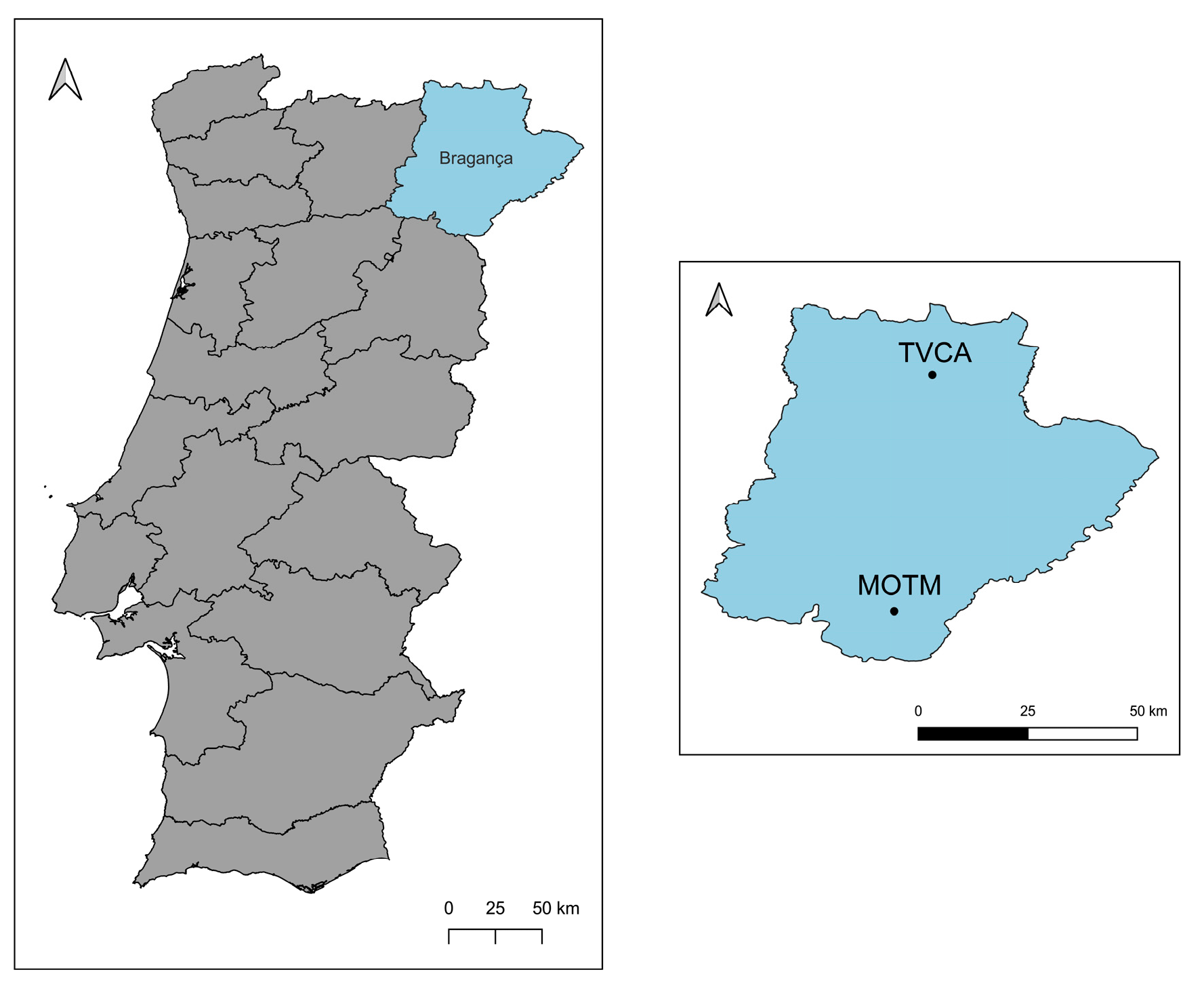
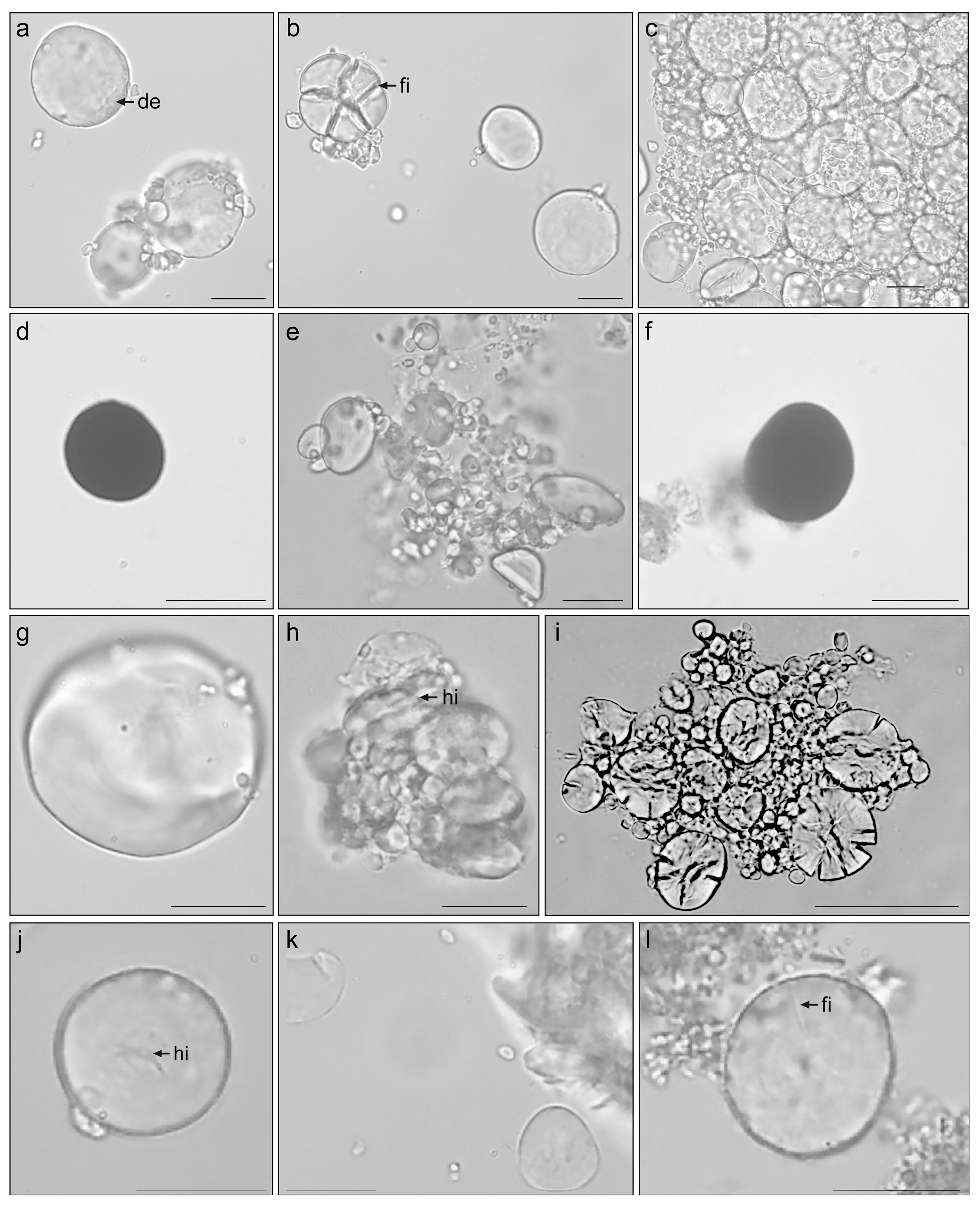
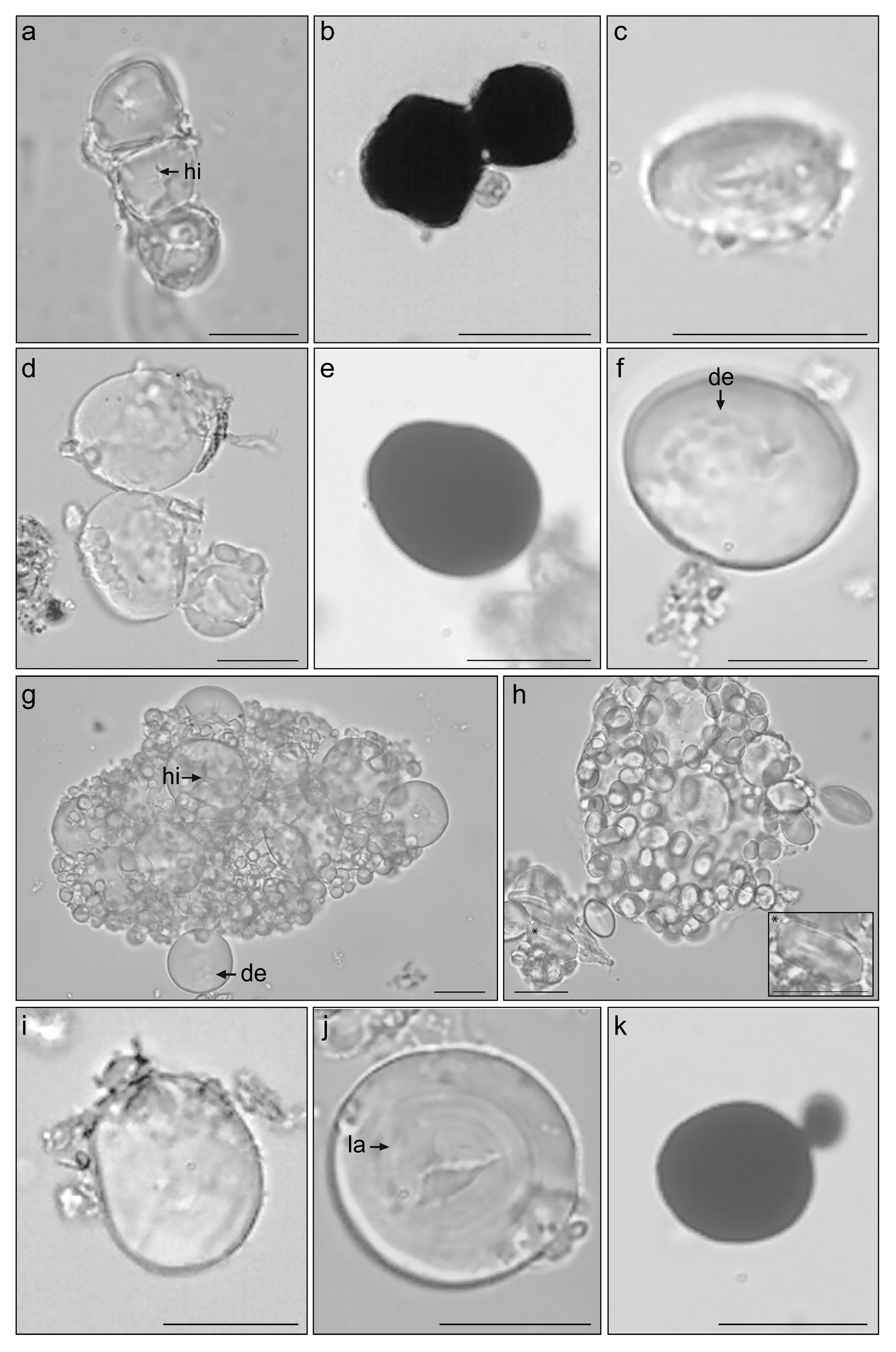
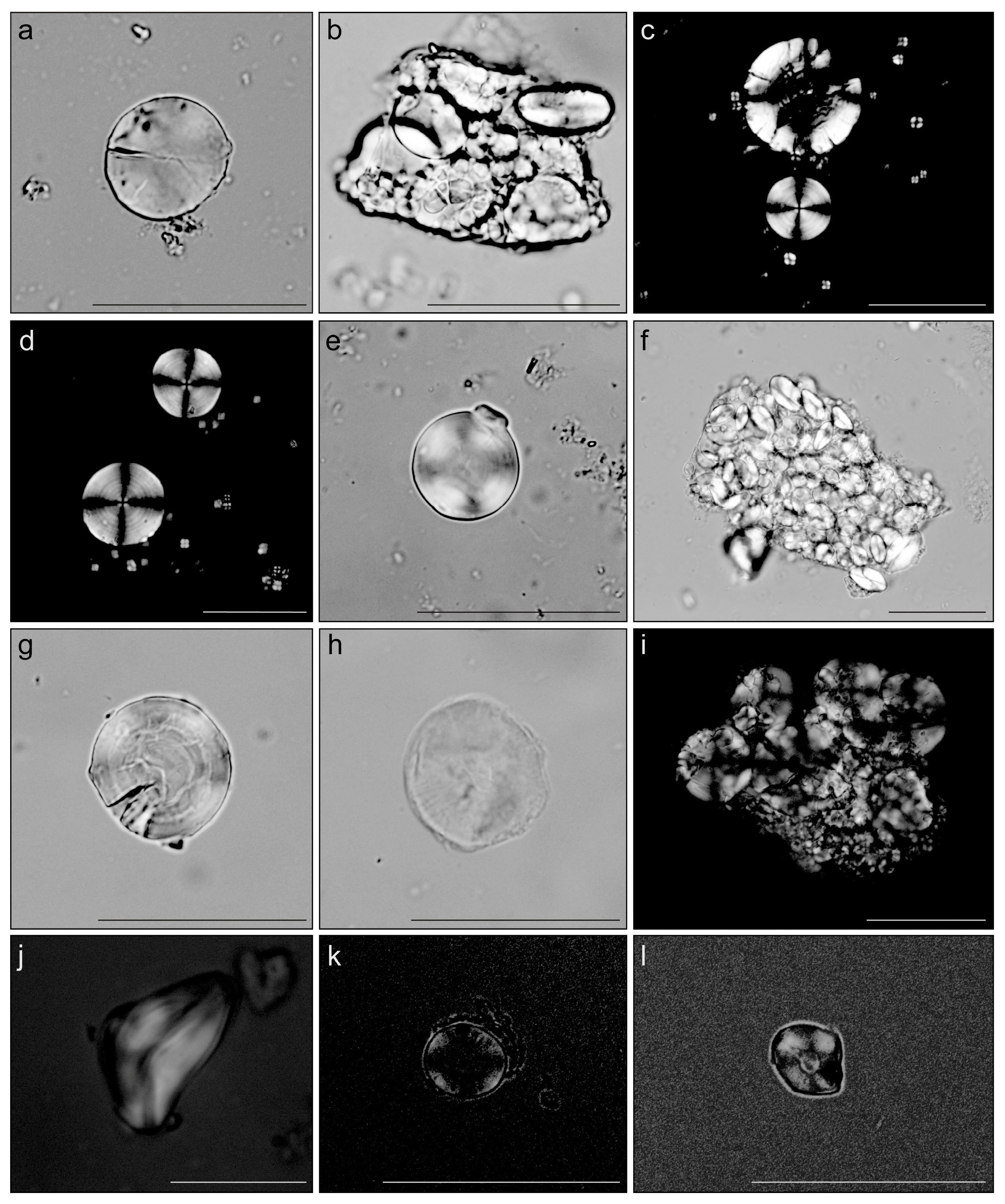
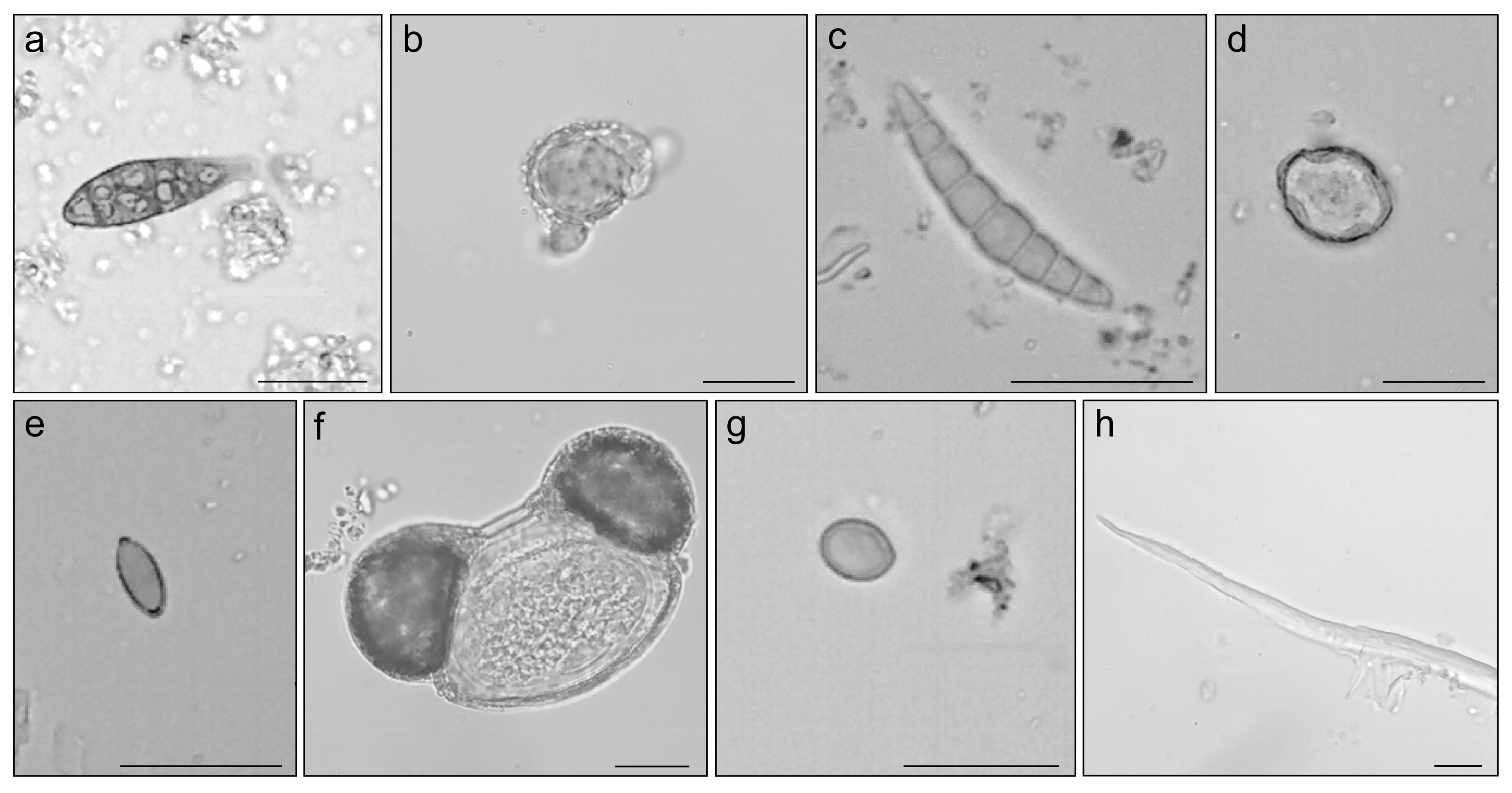
| Individual/ Micro-Remains | TVCA1 F | TVCA2 M | TVCA3 Adult | TVCA4 M | TVCA5 M | TVCA6 F | TVCA7 F | MOTM1 M | MOTM2 F | MOTM3 F | MOTM4 Child |
|---|---|---|---|---|---|---|---|---|---|---|---|
| Triticeae Type 1 | X | X | X | X | X | X | X | X | X | X | X |
| Paniceae tribe | X | X | |||||||||
| Fabaceae | X | X | |||||||||
| Pollen grains | X (Gnaphalieae) | X (Fumaria) | X (Pinus) | ||||||||
| Fungal spores | X (Alternaria) | X (Leptosphaeria) | X (Cladosporium) | X (Basidiomycota) | |||||||
| Fibers of sclerenchyma | X | X | X | X | X | X | X | X | X | X | X |
Disclaimer/Publisher’s Note: The statements, opinions and data contained in all publications are solely those of the individual author(s) and contributor(s) and not of MDPI and/or the editor(s). MDPI and/or the editor(s) disclaim responsibility for any injury to people or property resulting from any ideas, methods, instructions or products referred to in the content. |
© 2025 by the authors. Licensee MDPI, Basel, Switzerland. This article is an open access article distributed under the terms and conditions of the Creative Commons Attribution (CC BY) license (https://creativecommons.org/licenses/by/4.0/).
Share and Cite
Coutinho, A.P.; Tereso, S.; Carvalho, P.C.; Neves, M.; Catarino, L.; Silva, A.M. Exploring Diet in the Middle Ages in Northeastern Portugal (Bragança) Through Dental Calculus: The Cases of Torre Velha (Castro De Avelãs) and Mós (Torre De Moncorvo). Heritage 2025, 8, 379. https://doi.org/10.3390/heritage8090379
Coutinho AP, Tereso S, Carvalho PC, Neves M, Catarino L, Silva AM. Exploring Diet in the Middle Ages in Northeastern Portugal (Bragança) Through Dental Calculus: The Cases of Torre Velha (Castro De Avelãs) and Mós (Torre De Moncorvo). Heritage. 2025; 8(9):379. https://doi.org/10.3390/heritage8090379
Chicago/Turabian StyleCoutinho, António Pereira, Sofia Tereso, Pedro C. Carvalho, Mariana Neves, Lídia Catarino, and Ana Maria Silva. 2025. "Exploring Diet in the Middle Ages in Northeastern Portugal (Bragança) Through Dental Calculus: The Cases of Torre Velha (Castro De Avelãs) and Mós (Torre De Moncorvo)" Heritage 8, no. 9: 379. https://doi.org/10.3390/heritage8090379
APA StyleCoutinho, A. P., Tereso, S., Carvalho, P. C., Neves, M., Catarino, L., & Silva, A. M. (2025). Exploring Diet in the Middle Ages in Northeastern Portugal (Bragança) Through Dental Calculus: The Cases of Torre Velha (Castro De Avelãs) and Mós (Torre De Moncorvo). Heritage, 8(9), 379. https://doi.org/10.3390/heritage8090379





